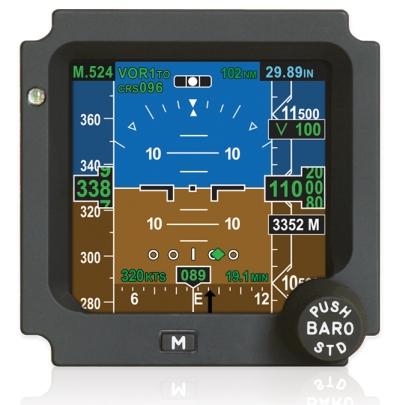Thu, Apr 05, 2012
New Standby Offers Improved Compatibility, Additional Customization Options
L-3 Avionics Systems announced Wednesday the release of its updated and enhanced GH-3900 Electronic Standby Instrument System (ESIS). Added features and a new lower price make the instrument a more customizable and affordable standby solution. The GH series of products will be on display at the AEA International Convention and Trade Show in Washington, D.C.

“The trend toward more versatile PFD and MFD layouts that can be adjusted to meet a variety of missions is increasing in all flight operations categories. We believe all standby systems should have that same level of utility,” said Larry Riddle, vice president of business development for L-3 Avionics Systems. “Our next-generation GH-3900 features a virtually unlimited number of configuration options and can interface with a wide range of onboard equipment, creating a high degree of parity between the primary and standby instruments.”
Designed to Level A software and hardware standards, the GH-3900 ESIS is capable of satisfying airworthiness requirements for almost any transport category fixed- or rotary-wing aircraft. Rendering all the important cues on a sunlight-readable 3-inch display, the instrument is a more precise and information-rich standby than traditional analog instruments.
With a customizable layout, GH series instruments can be modified to match a wide range of primary systems, giving pilots a familiar reference by which to fly the aircraft. Hardware enhancements include a variety of air data and heading input selections, as well as optional built-in accelerometers that provide external LRUs with relative data. Sensor and air data advancements, along with more efficient printed circuit board designs provide for a smaller and lighter form factor with increased reliability.
Additional GH-3900 features include:
- Configurable display of flight cues, colors, data presentation and aircraft performance parameters
- 3-ATI size weighs less than 3 pounds
- LED backlighting
- Interfaces support ARINC 429, RS-422 Serial Bus, RS-232 Serial Bus, discrete and analog input signals
- Designed for Part 25 and Part 23 (Class III & IV) aircraft as well as Part 27 and Part 29 rotorcraft
- Illuminated selector knob and menu button
- Modes for FMS, NAV, VOR, ILS and TACAN
- Installer-defined I/O interfaces, SSEC and VMO values
- Solid-state design increases reliability and accuracy while reducing costly repairs
- Field-loadable software
- Certified ARINC 429 outputs
All GH-series instruments are developed with L-3 Avionics Systems’ advanced solid-state expertise, which has made the company a leader in electronic standby instrument systems for high-end business and military aircraft.
More News
Aero Linx: Model Aeronautical Association of Australia MAAA clubs are about fun flying, camaraderie and community. For over 75 years, the MAAA has been Australia’s largest fl>[...]
Touchdown Zone Lighting Two rows of transverse light bars located symmetrically about the runway centerline normally at 100 foot intervals. The basic system extends 3,000 feet alon>[...]
“Discovery and innovation are central to our mission at Virgin Galactic. We’re excited to build on our successful record of facilitating scientific experiments in subor>[...]
How To Get A Story On Aero-TV News/Feature Programming How do I submit a story idea or lead to Aero-TV? If you would like to submit a story idea or lead, please contact Jim Campbel>[...]
Student Pilot Reported That During Rotation, “All Of A Sudden The Back Of The Plane Kicked To The Right..." Analysis: The student pilot reported that during rotation, “>[...]
 ANN's Daily Aero-Linx (05.02.24)
ANN's Daily Aero-Linx (05.02.24) ANN's Daily Aero-Term (05.02.24): Touchdown Zone Lighting
ANN's Daily Aero-Term (05.02.24): Touchdown Zone Lighting Aero-News: Quote of the Day (05.02.24)
Aero-News: Quote of the Day (05.02.24) ANN FAQ: Contributing To Aero-TV
ANN FAQ: Contributing To Aero-TV NTSB Final Report: Cirrus Design Corp SR20
NTSB Final Report: Cirrus Design Corp SR20



